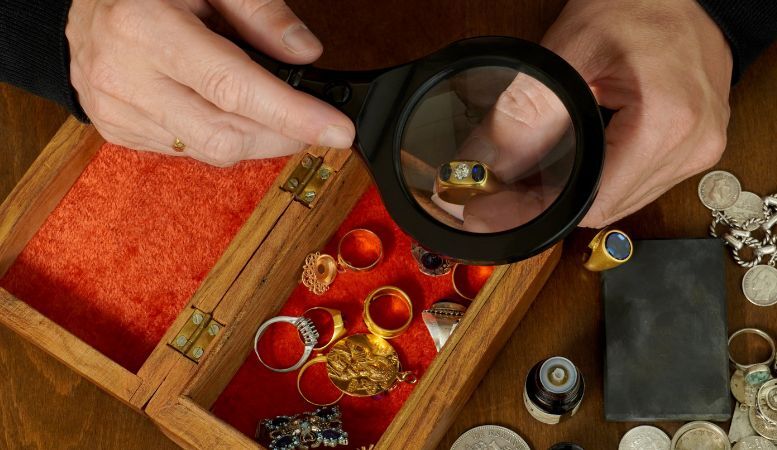Table of Contents
All gold coins or bars have percentages to display the gold’s purity and fineness. When you shop for gold jewelry, though, the language shifts to karats. Gold retail products provide a unique opportunity to invest in the precious metal while also purchasing a sentimental gift or heirloom that you or a loved one can enjoy for years to come.
Below, our expert team from Oxford Gold Group explains 18k vs. 22k vs. 24k gold so you can understand the composition and purity differences between the different types of products. For individualized investment support, you should consult your financial advisor.
Understanding 18k, 22k, and 24k Gold
Karat, abbreviated as k, is the term the gold retail world uses for gold content and purity. All gold products contain alloys of other metals, though some products will have higher gold contents than others. You might see gold-filled jewelry that only has gold as an outer layer around another metal. Karats help shoppers and investors understand how much gold is actually in the product they’re buying.
In practice, a karat is a specific measurement unit showing the proportion of gold in an alloy mixture out of a total of 24 parts. When you see 18-karat gold, what you’re really seeing is that 18 out of 24 parts of that mixture are gold, while the rest is an alloy mixture.
Following this math, 18k gold composition has a lower purity than 22k or 24k gold, typically averaging around 75% gold. 22k gold provides higher purity levels of around 91.7%. 24k gold offers the highest purity, with most products reaching above 99.9% purity.
18k vs. 22k vs. 24k Gold: What Are the Advantages?

Now that we have the gold karat levels explained, let’s compare 18k, 22k, and 24k gold. On the surface level, you may think that 24k provides the best investment options, though each retail product offers unique advantages:
- 18-karat: 18-karat gold comes at a lower price point, making it suitable for retail buyers interested in jewelry products and gifts for loved ones. The higher alloy mixture creates a harder, more durable finish, perfect for high-quality jewelry.
- 22-karat: 22-karat gold can provide the best of both worlds, working well in jewelry while also storing value because of the increased gold content. The product still has enough alloy mixture for semi-durable results.
- 24-karat: 24-karat gold is almost entirely pure, making it an excellent investment tool. The high purity level means a 24k gold piece can store value over long periods of time.
18k vs. 22k vs. 24k Gold: What Are the Disadvantages?
When considering 18k vs. 22k vs. 24k, you also need to take into account the disadvantages of the gold karat differences:
- 18-karat: The low purity levels in 18-karat gold mean you cannot use it for investment purposes. 18k gold also has wide color variations because of the higher alloy mixture.
- 22-karat: 22-karat comes at a higher price point, which could be a disadvantage, and does not provide ideal purity for investment purposes. 22k gold also has color variations from the alloy mixture.
- 24-karat: 24-karat gold costs the most and cannot be used in jewelry because of the soft finish.
18k vs. 22k vs. 24k Gold at a Glance

| 18k | 22k | 24k | |
| Purity | 75% | 91.7% | 99.9%+ |
| Fineness | 750 | 917.6 | 999.9 |
| Uses and Applications | Retail | Retail or investment | Investment |
| Cost | $47.98 per gram | $60.90 per gram | $66.36 per gram |
Purity
Choosing between 18k, 22k, and 24k gold typically boils down to purity. 24-karat products offer the highest purity levels, while 18k comes in with the lowest gold content. If you want something in between, you could choose 22-karat.
Fineness
Millesimal fineness is a calculation expressing the gold’s purity. Essentially, gold fineness multiplies the decimal by 1,000 to display parts out of 1,000. For example, 18k gold that is 75% pure has a fineness of 750.
Like with purity, 22k and 24k gold have higher fineness levels.
Uses and Applications
18-karat gold is used for jewelry and other retail purposes because the high alloy mixture creates a harder, stronger product. 24k gold is softer but of extremely high purity, making it perfect for investment purposes. 22k gold lies between the two, allowing it to serve both functions.
Cost
18-karat gold is the cheapest of the three by gram, then prices go up from there. 24-karat gold costs the most because it contains the highest gold content.
How Is Fineness Calculated for 18k, 22k, and 24k Gold?
You can calculate millesimal fineness for 18k, 22k, and 24k gold by dividing the purity by 100, and then multiplying that decimal by 1,000. If you don’t know that purity, divide the karats by 24 first.
Here’s an example:
18 karats divided by 24 equals 75, making the purity 75%. Now, divide the percentage by 100 to return to your decimal of 0.75. Next, multiply the decimal by 1,000 to get the millesimal fineness of 750.
You can conduct the same math on 22k gold and 24k gold to get 917.6 and 999.9, respectively. Many European countries choose to depict gold content using fineness, so understanding such figures can be helpful when shopping.
18k vs. 22k vs. 24k Gold: Which Karat Is Best for Jewelry?

When comparing 18k vs. 22k vs. 24k gold for jewelry purposes, the winner is clear. While you may feel tempted to choose the high-purity option, 24-karat gold does not create durable products. The best karat for gold jewelry products is 18.
18-karat gold has enough alloys in the mixture to create a highly durable and hard result, so the jewelry can resist everyday wear and tear. Gold is not a strong enough metal for jewelry on its own, so the alloy mixture is essential for superior jewelry. At the same time, 18-karat gold still has a higher gold content than 10k and 14k gold.
Which Is Better for Investment Purposes?
When looking for gold, know that 24-karat gold is typically best for investment purposes because it contains the highest gold content, allowing it to retain its value over time as the raw precious metal appreciates. When comparing 22k vs. 24k gold purity, you’ll see that 22-karat gold also provides above 90% gold content, which can work well for some investments, depending on your goals.
If you’re looking for a lower price point, 22-karat gold could work as an investment tool, especially when it has numismatic value as a collectible coin.
In general, though, if you’re interested in gold investing, you may want to look for the highest purity investment-grade gold available. The price may be higher, but the product should retain its value better over time. For more specific investment support, you should consult your financial advisor.
Oxford Gold Group Offers High-Purity Gold
Now that we’ve covered 18k vs. 22k vs. 24k gold, you can begin shopping. If you’re interested in higher-purity products near the 24-karat range, you’ve come to the right place.
At Oxford Gold Group, we offer numerous high-purity IRA-eligible gold coins and bars, including the highest-purity gold coin available on the market, the Gold Canadian Maple Leaf. You can purchase our coins and bars directly or open a gold IRA account to begin saving for your future in a tax-advantaged way.
Shop our high-purity gold online today or contact Oxford Gold Group at (833) 600-4653 to learn more about our gold IRA options.








